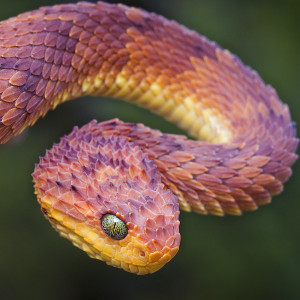
General Description: Known for their unusual prickly scales and considered dangerous
Length: Females tend to be slightly larger than males, reaching an maximum length of 73 cm (29 inches). The maximum length for males is 58 (23 Inches)
Coloring: Bright colours as a warning against their venomous nature.
Fangs: It has long, tubular, hollow fangs, which are supplied with venom by a gland located on the upper jaw, between the eyes and mouth. These retractable fangs are connected to a bone that can shift posteriorly within the upper jaw to house the fangs.
Disposition: nocturnal and like other vipers, is an ambush predator. As such, it spends a large amount of time laying in wait for potential prey to enter its immediate environment. Once in range, A. squamigera strikes very rapidly, with speeds recorded in milliseconds. It spends large amounts of time in one place due to this predatory behaviour. Except during mating periods, A. squamigera is a solitary species.
Diet: It feeds mainly on small, nocturnal mammals such as shrews and rodents. Less commonly, it feeds on birds and small reptiles
Defences: To avoid predation, green bush vipers rely on the same mechanisms used for hunting. Their camouflaged scale patterns allow them to blend in with the surrounding environment. This colouration serves a two-fold purpose, allowing the viper to strike and surprise potential prey, and go unnoticed by potential predators. This ambush-based hiding and hunting behaviour allows the snake to sometimes hide rather than engaging in defensive or aggressive behaviour. The bright colouration also serves as a warning of the snake's venomous nature to potentially threatening animals.
Venom: Not much is known about their venom except that it is strongly hemotoxic, causing pain, swelling, and blood clotting problems. Until recently, their venom has often been regarded as less toxic than that of many other species, perhaps because bites are uncommon, but this turned out not to be the case. There are now a number of reports of bites that have led to severe hemorrhaging. One case was fatal.
